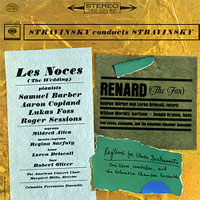Stravinsky • Les Noces, Renard, Ragtime for Eleven Instruments
 gor Stravinsky began preliminary
sketches for Les Noces as early as 1912, but he was busy working on The Rite
of Spring and wouldn't complete the final score until 1923. It was based on folk
themes and poetry, and Stravinsky would describe the ballet as a collection of
"cliches and quotations of typical Russian wedding sayings." As you read the
libretto, the same phrases keep repeating, much like hearing snippets of conversation from
many people discussing and preparing for the wedding. If you are familiar with Carl Orff's
Carmina Burana, then Les Noces will seem familiar, but certainly less
melodic. Orff admitted being influenced by hearing Les Noces and modeled much of Carmina
on Stravinsky's work. gor Stravinsky began preliminary
sketches for Les Noces as early as 1912, but he was busy working on The Rite
of Spring and wouldn't complete the final score until 1923. It was based on folk
themes and poetry, and Stravinsky would describe the ballet as a collection of
"cliches and quotations of typical Russian wedding sayings." As you read the
libretto, the same phrases keep repeating, much like hearing snippets of conversation from
many people discussing and preparing for the wedding. If you are familiar with Carl Orff's
Carmina Burana, then Les Noces will seem familiar, but certainly less
melodic. Orff admitted being influenced by hearing Les Noces and modeled much of Carmina
on Stravinsky's work.
Stravinsky had considered a huge orchestra for Les Noces but settled on the final orchestration of four soloists, four pianos, chorus and six percussionists. This choice of a smaller ensemble meant it would never be a sonic tour de force like his Rite or Firebird. Dedicated to Sergei Diaghilev, founder of the Ballet Russes, Les Noces was first performed in 1923 by that ensemble with Ernest Ansermet conducting. This reissue is of the 1959 Columbia recording, which has great star power: Stravinsky conducting and the four piano parts played by Samuel Barber, Aaron Copland, Lukas Foss and Roger Sessions, each a leading American composer. Stravinsky takes a more measured approach to Les Noces than Bernstein or Robert Craft, which makes his version a bit staid. Side 2 of this LP has two seldom-performed jewels: Renard, whose performance bristles with energy and drive, followed by an enjoyable, playful reading of Ragtime for Eleven Instruments. Renard is described as a "Burlesque for Singing and Acting," telling a barnyard fable with some rather dark lyrics. The Ragtime for Eleven Instruments was composed after Stravinsky studied a collection of piano rags Ernest Ansermet brought back from America. Both of these pieces were influenced by Stravinsky's study of those scores and sound very much like his more famous L'histoire du Soldat, with punchy rhythms, angular melodic lines and bursts of virtuosic display. Also, both selections use the cimbalom, a Eastern European dulcimer with damper pedals similar to a piano. Stravinsky used the cimbalom to imitate an ancient Russian instrument, the guzla, which is a metal-stringed balalaika. He was so fond of the cimbalom that Ragtime was composed on that instrument. Unfortunately, Stravinsky decided to abandon writing for the cimbalom due to the lack of trained musicians for the instrument. Speakers Corner has done a wonderful job at reproducing the original Columbia release's cover and the accompanying lyrics insert. It's great to see the composer and the dream team of piano soloists pictured on the album insert, along with a shot of the recording session with all of the pianos and percussionists. Soloists are clearly heard in the mix, but I would have liked more clarity from the chorus responses, as they are obscured by the instruments too often. The choir often lacks clarity and that detracts from the recording. Percussion is quite powerful and triangle is clearly reproduced, particularly in Renard. I'd also mention the fine performances of the wind players in Renard as they execute those wicked runs and flourishes. While this recording may not be a sonic spectacular, it
is enlightening to hear a mature Stravinsky's interpretation of music from his youthful
and prolific period of composing. Les Noces is an influential piece of early
Stravinsky writing, but it's Renard and Ragtime to which I will return. |
